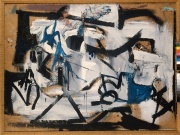Difference between revisions of "Beaverboard"
Jump to navigation
Jump to search
(username removed) |
|||
| Line 2: | Line 2: | ||
== Description == | == Description == | ||
| − | Originally a trademark of the Beaver Board Company (1905) for a pulp composite [ | + | Originally a trademark of the Beaver Board Company (1905) for a pulp composite [[wallboard]] made from wood pulp and/or waste paper. Now the term beaverboard is generally used for a variety of rigid, laminated [[fiberboard|fiberboards]]. Beaverboards became a popular interior finish wallboard because they were available in many types of finishes, such as pebble-surfaced, and could be painted or decorated with stenciled designs instead of wallpaper. |
== Synonyms and Related Terms == | == Synonyms and Related Terms == | ||
Revision as of 12:11, 8 January 2014
Description
Originally a trademark of the Beaver Board Company (1905) for a pulp composite Wallboard made from wood pulp and/or waste paper. Now the term beaverboard is generally used for a variety of rigid, laminated fiberboards. Beaverboards became a popular interior finish wallboard because they were available in many types of finishes, such as pebble-surfaced, and could be painted or decorated with stenciled designs instead of wallpaper.
Synonyms and Related Terms
beaver board; fiberboard; wallboard;
Additional Information
C. Gould, K. Konrad, K. Milley, R. Gallagher, "Fiberboard", in Twentieth-Century Building Materials, T. Jester (ed.), McGraw-Hill: New York, 1995.
Authority
- Ralph Mayer, A Dictionary of Art Terms and Techniques, Harper and Row Publishers, New York, 1969 (also 1945 printing)
- Thomas C. Jester (ed.), Twentieth-Century Building Materials, McGraw-Hill Companies, Washington DC, 1995
